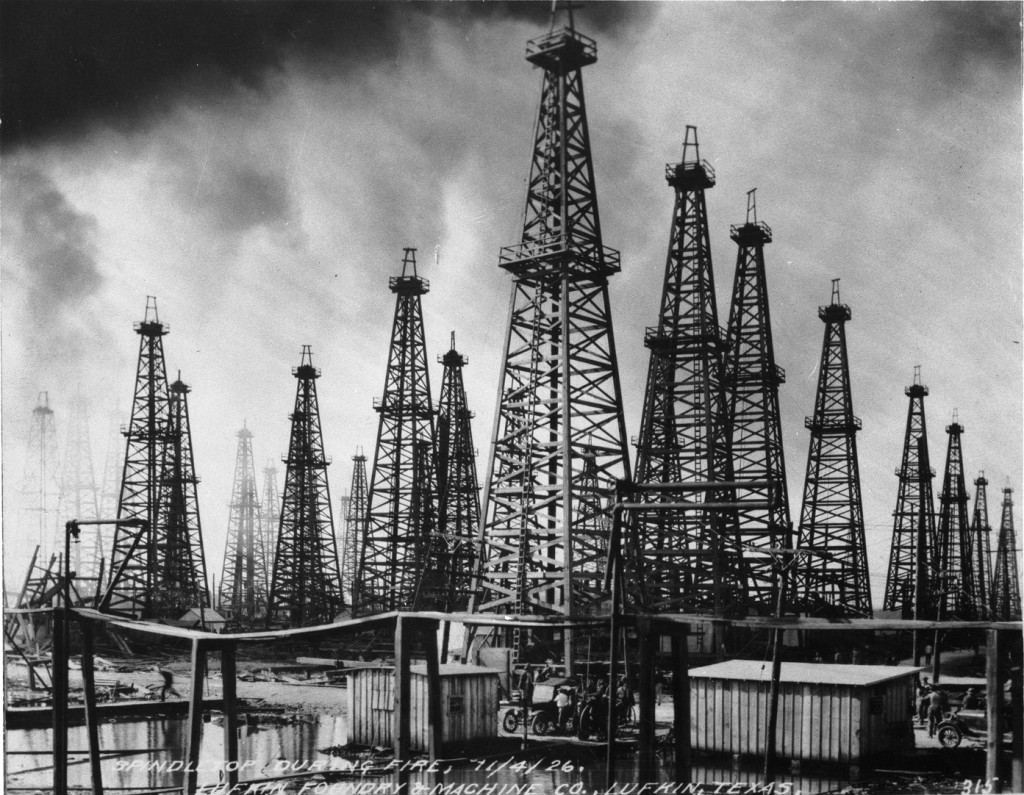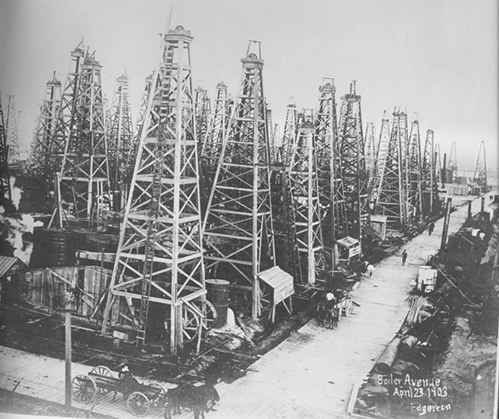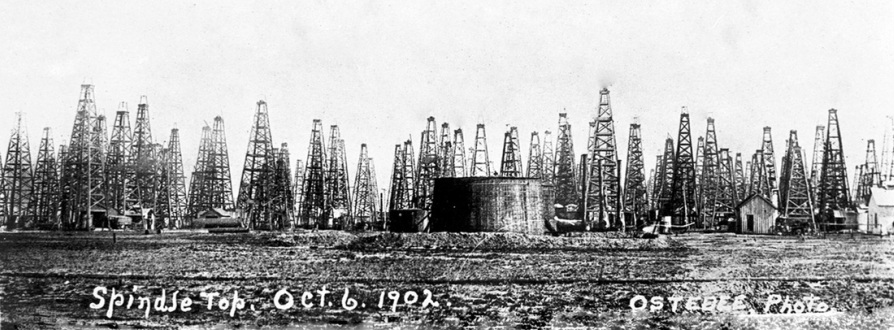Our intrepid reporter takes a deep dive into the invention of drilling mud, a staple that would forever change the fortunes of the oil and gas industry.
by Bobby Weaver
In today’s oil patch, the use of the drilling fluid called “mud” as an integral part of the drilling process is a foregone conclusion. The exact formula for mixing mud to enhance drilling speed, keep bits cool, and control excessive gas pressures, as well as serve a myriad of other well drilling activities, has become something of an oilfield specialty. The development of drilling mud for enhanced oil well drilling is a long story that starts out simply, but gets complicated—much like the evolution of the oil and gas industry.
It all began in the 1890s, when rotary drilling was first introduced at Corsicana, Texas. In those days, rotary drilling was a totally new and different technology. The process required large amounts of a circulating fluid to flush cuttings out of the hole as opposed to the old tried and true cable tool drilling which only needed enough fluid to make a slurry of the cuttings which were from time to time bailed out of the hole. The most available fluid—water—was the logical choice for a drilling fluid and it worked very well, with little effort or thought being given to making any changes.
In the fall of 1900, when the Hamil brothers were hired to bring a rotary to Beaumont to drill what was to become the Spindletop discovery well, all that began to change. The reason a rotary was used there is that several attempts to drill on the salt domes of the area had been unsuccessful due to the loose unconsolidated nature of the formations along the Gulf Coast. Around mid-October of 1900, the Hamils spudded in to drill to a contracted depth of 1,200 feet. They almost immediately encountered the same problems as their cable tool predecessors. After drilling through 160 feet of the “gumbo,” as the local shale was called, they encountered a coarse porous formation they called the “heaving sand” and lost circulation.
Unable to drill without a fluid return, they rigged up an apparatus to pile-drive casing through the formation and as each 20-foot section of pipe was added, the sand was flushed out. It took three weeks of backbreaking work, but, at a depth of 445 feet, they encountered the gumbo again and began to drill. With the lost circulation problem over, they managed to drill to a depth of between 640 and 700 feet, where they encountered another coarse sand formation and once again lost circulation. By that time, it was early December and the thought of going through another pile-driving ordeal was almost unbearable.
After wrestling with the problem for several days, Al Hamil, who was acting as driller, decided to take their dulled bits to Corsicana to sharpen and modify them in order to help the situation. He left his brother Curt at the rig. along with their lone roughneck, a fellow named Peck Byrd, to clean up the rig and get it ready for drilling upon his return. The three days Al was gone from the job proved to be a most important moment in the history of the oil and gas industry, not to mention probably being the salvation of the Spindletop well. They invented drilling mud.
As Curt and Peck went about cleaning up the job site, their main topic of conversation revolved around how to solve the lost circulation problem. The very thought of going through the pile driving ordeal again was not an option. They had noticed that while drilling through the gumbo the drilling fluid had become somewhat muddied which seemed to help with circulation. That led to the idea that maybe if they could somehow make a thicker muddied drilling fluid it might seal off the porous sand formation and keep them from the back breaking labor of pile driving pipe through the formation.
With that thought in mind, they talked to a local farmer, the Reverend John C. Chaney, with whom they had contracted to dig their drilling fluid pit. Chaney, who was on hand to clean the sand from the pit anyway, agreed to plow the clay-bottomed pit as deep as he could. Once the ground was thoroughly plowed, they ran some water into the pit, turned the farmer’s small herd of cows into the water, and drove them around and around until the whole thing became a mass of thick mud about a foot thick.
By the time Al returned to the job, his two roughnecks were gradually adding water to the resulting mass of mud and circulating it with the drilling fluid pumps in order to thin it enough to use as drilling fluid. To say that Al was dismayed might be an understatement. After much wrangling and general discussion, he finally agreed to the idea, although he was convinced that his new bits were the answer to the problem. When they resumed drilling using the new drilling fluid, it appeared that the elder Hamil was right because, for the first three or four hours, nothing happened. Then with about half the reserve pit empty circulation gradually began to return. By the end of the day, drilling was back to normal as the mud began to create a sheath around the edges of the hole and seal off the problematic sand formation. With only one day’s work, they drilled through the sand and back into the gumbo. By Christmas Eve, the well was down to a depth of 920 or 930 feet and after three more months of backbreaking labor, the Hamil boys decided to shut the job down over the holidays.
They returned on New Year’s Day and resumed work to complete the job to the contracted depth of 1,200 feet. After three or four days, they had made an additional hundred feet when they once again developed downhole problems and shut down to fabricate a new drill bit. While going back into the hole with new tools on the morning of Jan. 10, 1901, the well blew in with an estimated production of approximately 100,000 barrels per day and the oil industry in Texas was born.
Without the development of drilling mud used by the Hamil brothers and their crew, it is very probable that the well would not have been completed. Needless to say, the common-sense development of a technique of enhancing drilling was here to stay. The use of locally available clays to create the product was quickly adapted by all drilling outfits who were active in the shallow unconsolidated formations that existed along the Gulf Coast, and jobs that had heretofore taken months were shortened to weeks.
In 1913 and 1914, the U.S. Bureau of Mines issued technical bulletins on drilling muds, which began the long history of the science and engineering behind the use of the material. However, it was not until the late 1920s—when materials such as barite and iron oxides (added for weight) were introduced, along with mined bentonite clays that replaced locally used clays—that the science of drilling mud began to really develop. It was during that time that the first commercial drilling mud companies such as Baroid developed.
It took years for the rotary drilling method to become accepted outside the Gulf Coast area. The cable tool men put forth a myriad of reasons why rotaries were not a good idea. Those ideas included a multitude of mechanical considerations, but ultimately the objections centered on the use of drilling mud. They maintained that using mud did not work well in the harder formations plus it made it next to impossible to determine what formations were being drilled. However, their most often-used argument was that the mud sealed off the smaller pay zones and caused them to be bypassed and even prevented known oil formations from being produced. The question became so hotly debated that in 1931, the American Petroleum Institute conducted an extensive study on the subject and concluded that all the traditional anti-mud arguments were unfounded.
Nevertheless, those arguments had such a strong hold on the thinking of the day, that up through the 1940s, most wells drilled by rotaries were completed by cable tools. As a well neared the pay zone the rotary was pulled off and a cable tool drilled the well in so as not to seal off the production zone. Nowhere was that more evidenced than by the development of a series of combination rigs during the 1920s—rigs that could be converted from rotary to cable tool in order to complete wells in the generally accepted manner. Ultimately the contest between rotaries and cable tools became a moot point as wells began to assume depths that were beyond the capabilities of the cable tools, causing them to be phased out.
By the 1930s, as a consequence of deeper drilling, with its corresponding technical problems, serious work on engineered drilling mud began in earnest. Oil companies established major research programs on the subject of mud design during that period. By the end of WWII, in the mid-1940s, the use of mud engineers whose job was to provide better mud management in oil well drilling became a reality. Since then, that activity has increased notably since the 1970s, when environmental regulations became a major aspect of oil well drilling.
Almost from the beginning of mud use, the problem of maintaining the proper makeup for optimum drilling conditions was an important aspect of the work. At first, it was the job of the derrick man to check the mud and add more water or more mud to the mix. It was pretty much an eyeball situation in those early days. Sometime in the 1920s and early 1930s, when specialty mud companies developed and they began to provide additives to the mud to solve a variety of drilling problems associated with well-depth and associated complexity, the job of the mud engineer assumed more and more importance. At first the samples were still caught by the derrick man and he was advised by the engineer on what to do. Over time, that job has pretty much devolved on the mud man, who is now in general charge of the nature of the drilling fluids used on modern drilling rigs.
All that development over the years has led us to today’s drilling fluid situation that has become one of the most important aspects of the work. Drilling engineers maintain an almost constant eye on what is being used and the various special mixtures of mud are maintained with a precise degree of accuracy. We have traveled a long road since the days when a little plowed ground muddied up some water to provide the first drilling mud for the oil and gas industry.
Bobby Weaver is a regular contributor to Permian Basin Oil and Gas Magazine.













